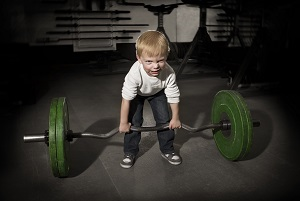MEDIA // NEWS

How Young is Too Young for Weightlifting
November 27, 2025 at 1:00 PM EST.The Journal of American Medical Association says that once kids hit the teen years, physical activity plummets. In fact, less than a third even get an hour of daily exercise. This inactivity can lead to obesity, heart disease, high blood pressure, diabetes, etc. We don’t need to educate you on more reasons why it’s important to encourage your children to exercise. But is weightlifting taking it too far? The fitness community’s opinion specifically on whether weightlifting is healthy for children is complex and divided.
There is a long running debate on whether kids should weightlift. Most experts have historically leaned towards the view that it is unsafe for children to lift weights. The general consensus in the past has been that weight training could damage kids’ growth plates, cause pre-mature bone fusion, and/or stunt their growth. In fact, the American Academy of Pediatrics (AAP) released policy statements in the 80’s and 90’s advising against weightlifting for preadolescents.
However, in 2008, the AAP revised its statement, based on new research that determined it’s safe for children to start “light” strength training after age 8. The AAP publication states, “Appropriate strength-training programs have no apparent adverse effect on linear growth, growth plates or the cardiovascular system.” It is important to note that the AAP recommends strength training- not to be confused with weightlifting or powerlifting.
Strength training programs usually include the use of free weights, weight machines, elastic tubing, or an individual’s own body weight. Its purpose is to build strength in an athlete, as well as prevent injuries within other sports.
On the opposite end, weightlifting and powerlifting are usually focused on competition, with athletes vying to lift heavier weights or build bigger muscles than other athletes. This type of lifting, which usually includes explosive maximal or near-maximal lifts, can put strain on vulnerable parts of a growing body, such as the spinal and neck regions. The AAP guidelines specify, “Preadolescents and adolescents should avoid power lifting, body building, and maximal lifts until they reach physical and skeletal maturity.”
In fact, Edward Laskowski, M.D., a physical medicine and rehabilitation specialist at Mayo Clinic in Rochester, Minnesota, says, “Heavy lifting can put too much strain on young muscles, tendons and growth plates, especially when proper technique is sacrificed in favor of lifting larger amounts of weight.”
The National Strength and Conditioning Association issued guidelines for strength training in prepubescent children. They include (but are not limited to):
- The general recommended age is when a child is ready to participate in sports activities (generally 7 or 8 years old).
- Children should also be sufficiently mature that they can easily follow instructions.
- Strength training should only be one part of a child’s exercise program.
- Special care should be taken to avoid overuse injuries, which children are more prone to. In other words, exercise routine needs to be varied to prevent extra stress on any one part of the body.
- Children should be taught proper form and technique during all lifts. Kids are more susceptible to injury because their muscles systems are underdeveloped.
- A light warm-up before and a light cool-down after a training session is imperative.
The American College of Sports Medicine (ACSM) acknowledges that in addition to the obvious goal of getting stronger, strength training programs may help improve sports performance and prevent injuries among children, as well as enhance overall health. Similar to strength training among the geriatric population, strength training in children may stimulate bone mineralization, have a positive effect on bone density, help maintain a healthy weight, increase cardio respiratory function, and increase muscle endurance. Recent studies actually show increased strength, overall function and mental well-being in children with cerebral palsy who undertake mild strength training.
Experts also warn that many weightlifting machines are not built for preadolescent bodies, and therefore it’s safer to stick with free weights, which can easily be manipulated by children. The ACSM specifically coaches that children should work with resistances that allows them to perform no fewer than eight repetitions in a row. In other words, children should be focused on lighter weights with higher reps during their strength training sessions. One last suggestion for parents thinking about incorporating strength training into their child’s exercise regime: Children should be supervised at all times during their strength training sessions, and during any time spent in the weight room.
